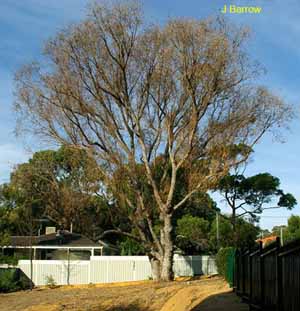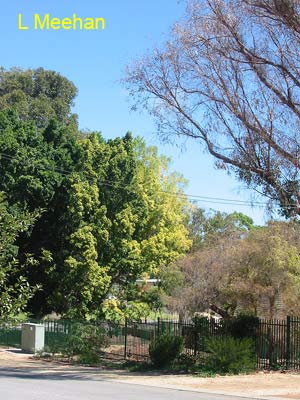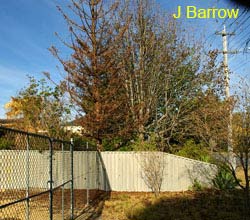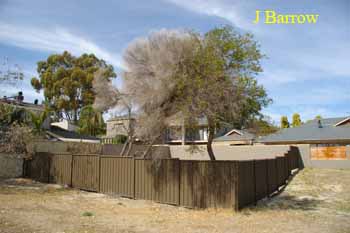
Herbicide Yellows
Jim Barrow and Lis Meehan
Most of the city of Perth, Western Australia, is built on fairly coarse dune sand. Water infiltrates into this sand is a very rapidly. This characteristic is utilised by many local government authorities in dealing with water run-off from roads and other paved areas. The water is led to small reserves, each of a few hundred square metres in area, at low points in the landscape. Within each area, locally known as a "sump", the sand is excavated to a depth of 2 to 3 m and the water is discharged into this excavation. From there, it rapidly moves downwards to augment the water table. Most of the run-off from house roofs also finds its way into the water table.

Although water moves quickly downwards, it moves much more slowly sideways, eventually draining into the sea on one side or to the Swan River on the other. This gives rise to an "mound" of groundwater. When the surface of this mound is higher than the ground level we have a lake. Many residents install bores on their property into the water table and use the water on their gardens during the dry summer months. The groundwater is thus an important resource.
When the excavated area has steep sides the sumps are securely fenced, and usually surrounded by screening vegetation.
Native trees originally present within the area are left and trees may also be planted thus making the sumps important wildlife refuges. Often the sumps are adjacent to residential blocks, and the owners have planted trees in their gardens.
We also need to explain that Perth is administered by several local government authorities each responsible for specific areas. Two such authorities are specially relevant to this story: the City of Stirling, and the City of Joondalup. The neighbouring cities of Cambridge and Nedlands are also mentioned.
The timing of the problem
In January 2007, one of us (LM) noted that in a sump close to her house one very large Tuart ( Eucalyptus gomphocephala ) and two old peppermints ( Agonis flexuosa ) had been dying back very badly over the last 6 months or so. The Tuart seemed to be beginning to recover, sprouting new growth from its large trunks in the manner of a tree which has been burnt (Figures 1 and 2).

Fig. 1 - Healthy Tuart in Mid 2005 |
|

Fig. 2 - The same tree in April 2007 |
The nature of the problem
It was subsequently found that similar problems were occurring in all of the sumps inspected within the cities of Stirling and Joondalup (Figure 3). Almost all plants within or very close to the sump areas had died.The leaves of the affected plants were often chlorotic on the branches nearest the sump (Figure 4).

Fig.4 - Chlorotic on the branches nearest the sump |
|

Fig.3 - Dead trees in a garden adjacent to a sump
|
| |

Fig.5 - A Tuart attempting to resprout |
On badly affected plants, the leaves turned brown, shrivelled and died. Attempts by the plant to regrow met the same fate (Figure 5).
In a sump in bushland in the Warwick Open Space Conservation Area, a state government Bush Forever Site, damage extended for at least 25 m and perhaps as much as 50 m (Figures 6 and 7).

Fig. 6 - Damage to bushland |
|

Fig. 7 - Close up view of damage |
In the neighbouring City of Cambridge, and in the City of Nedlands (which has similar soils) the sumps were unaffected. The sump shown in Figure 8 is in the City of Stirling and is badly affected. The sump shown in Figure 9 is only 200 m distant but is in the City of Cambridge and is unaffected.

Fig. 8 - Plant damage near a sump |
|

Fig. 9 - Undamaged plants |
Mildly affected leaves were chlorotic between the veins (inter-veinal chlorosis). Severely affected leaves then shrivelled and died. A wide range of plants was affected (Figure 10).

Fig. 10 - Chlorotic foliage
What caused these problems?
All of these observations are consistent with the conclusion that the sumps in Stirling and Joondalup were sprayed with a triazine herbicide during the winter (July-August) 2006. Triazines are known to cause an initial yellowing followed by desiccation and leaf browning.
This is confirmed in the minutes of Stirling council (see page 57) which state that hexazinone was used.
This herbicide has the structure indicated in the accompanying diagram. It has a ring with 3 N atoms and hence the general name "triazine". Its full chemical name is:
3-cyclo hexyl-6-(dimethylamino)-1- methyl-1,3,5-triazine--2,4-dione .
Hence "hexazinone"
All formulations of this herbicide carry warnings such as the following:
NOT TO BE USED FOR ANY PURPOSE, OR IN ANY MANNER CONTRARY TO THIS LABEL
UNLESS AUTHORISED UNDER APPROPRIATE LEGISLATION. The product may kill many trees and other desirable plants if not correctly applied.
DO NOT apply on or near desirable plants, or on areas where their roots may extend. As
guidance this is two times their height, or more depending on the species and other conditions.
DO NOT apply in areas where a surface flow of water could wash the chemical into areas where
roots of desirable trees or plants may extend.
The long term effects
Hexazinone is a residual herbicide. It is meant to persist in soil for a considerable period. We do not know how long it will persist in these sandy, alkaline soils. The pathways by which the chemical degrades involve removal or modification of some of the side chains. The triazine ring remains, and the product might well still have some herbicide activity. It is therefore feasible that it may remain active for periods of several years. Furthermore, it is probable that some of the herbicide has found its way into the water table. It is probable that it will then moved sideways producing a plume of damage "downstream".
Further implications
The symptoms observed here were very severe, had a sudden onset, and were confined to specific locations. It is therefore easy to associate them with a known use of herbicide. In contrast, much milder symptoms are widely observed. The leaves of trees become chlorotic and the trees slowly die back. Such occurrences have been called Mundulla yellows. Three causes for this disease have been proposed.
It was initially suggested that it was caused by an infectious agent, but this explanation has now been discounted. A second explanation is that it is caused by applications of triazine herbicides to parts of the root system (reference 1 and 2). This explanation was not accepted by the authors of the third explanation, who proposed that it is caused by iron deficiency on alkaline soils.
The present observations show that trees some distance from the site of herbicide application can show inter-veinal chlorosis. Many of these trees do not (yet) shows signs of decline. It will be interesting to see whether these trees do "progress" to slow decline and death as is typical for Mundulla yellows. It will also be interesting to see whether symptoms appear "downstream" from any of the treated sumps.
Australian Plants online - 2007
Association of Societies for Growing Australian Plants
|